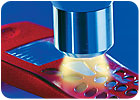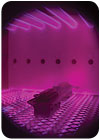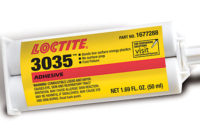Plasma treatment raises the surface energy of plastics to make them more amenable to bonding.

Plasma treatment makes plastic surfaces more wettable for adhesives, inks, paint and metallization processes. Here, a plastic cell phone housing undergoes plasma treatment prior to painting. Photo courtesy Plasmatreat North America Inc.
Polypropylene is used in a wide range of assemblies, because of its toughness, flexibility and resistance to heat, moisture and chemicals. In the medical device industry, it’s used for syringe barrels and fluid containers. In the appliance industry, it’s used for motor housings in vacuum cleaners, pump housings in dishwashers, and bodies for coffeemakers and steam irons. In the automotive industry, it’s used for bumpers, body panels, exterior trim, dashboards, fuel tanks, intake manifolds and battery cases.
However, the same properties that make polypropylene good for containing hot water and battery acid also make it difficult to bond with adhesives. The plastic has such low surface energy-just 30 dynes per square centimeter, depending on the formulation-that adhesives can’t adequately wet the surface to get a grip, whether chemical or mechanical.
To bond polypropylene and other resistant plastics, engineers need to raise the material’s surface energy. One way to do that is by exposing the surface of the plastic to plasma, the so-called fourth state of matter.
Plasma is a mixture of free electrons, ions, radicals and molecular fragments created when energy, such as electricity or microwaves, is applied to a gas. Treating plastic with plasma improves bondability in several ways. It removes grease and other organic contaminants that inhibit adhesion. It etches the surface of the plastic at a microscopic level, which improves the bond’s mechanical strength. And, most importantly, plasma chemically activates the surface of the plastic, making it more wettable and more likely to react with an adhesive.
“Plasma breaks up any long-carbon-chain contaminants on the surface,” explains Tim Smith, vice president of operations at Plasmatreat North America Inc. (Mississauga, ON). “Once these contaminants have been removed, the plasma can react directly with the surface of the substrate. Oxygen molecules from the ionized gas...are inserted into the hydrocarbon substrate to produce hydroxyl and carbonyl functional groups. It is through these water-soluble functional groups that a polar surface with high energy is produced.
“Most solvent- or water-based adhesives and coatings will form a strong chemical bond with these functional groups, resulting in adhesion properties that could not have been achieved without plasma treatment.”
Besides polypropylene, plasma treatment is effective on such polymers as ABS, PVC, polycarbonate, polyethylene, polystyrene, Santoprene, silicone, Teflon, Mylar and nylon. However, energy, exposure time and other parameters vary depending on the material, part size and bonding objectives, says Jeff Gradus, regional sales manager for Tantec EST Inc. (Glendale Heights, IL).
No special part designs are required-complex shapes and continuous films can be treated. Plasma can be directed at areas as large as a dashboard or as small as the inside of a needle hub on a syringe.
“Plasma is isotropic and nondirectional,” says Demetri Chrysostomou, Ph.D., director of technology at PVA Tepla America Inc. (Corona, CA). “It conforms to any three-dimensional object. It gets into nooks and crannies. It can get under silicon wafers on chip carriers and into fine polymer capillaries. It doesn’t suffer from line-of-sight problems, and it doesn’t cast a shadow.”
Despite the energy applied to the gas, plasma treatment is a relatively low-temperature process. It is environmentally friendly, and it’s safe for operators. A small amount of nitric oxide is emitted during treatment, and this may need to be vented depending on the layout of the system. The treatment does not produce ozone.
Plasma treatment does not change how the plastic looks or feels, nor does it alter the material’s inherent properties. In fact, it’s impossible to distinguish between treated and untreated parts except by checking how well liquids wet their surfaces.
“Because the treatment only penetrates the substrate to a depth of about three molecules, the physical properties of the substrate are not affected,” says Smith.
Plasma treatment is not limited solely to plastics or adhesive bonding applications. Plasma improves the bondability of metals, glass and ceramics. It enhances wettability and adhesion for inks and paints. It facilitates joining of dissimilar plastics in overmolding or in-mold assembly applications. And, it sterilizes plastic parts for medical applications.

When plasma treatment is done as a batch process in a vacuum chamber, engineers can control every variable of process, including the composition, flow rate, pressure and concentration of the gas, and the frequency and wattage of the electrical energy. Photo courtesy Tantec EST Inc.
Batch vs. Continuous Process
Plasma treatment can be done as a batch process in a chamber with a low-pressure atmosphere, or it can be done as a continuous process, on-line, at atmospheric pressure.With the former, engineers have the advantage of controlling every variable of process: the composition, flow rate, pressure and concentration of the gas, as well as the frequency and wattage of the electrical energy. This can be important if engineers want to produce a specific chemical composition on the part’s surface. Another advantage is that any object inside the vacuum chamber is treated on all sides by the plasma. The disadvantage of such a system is low throughput. The size of the vacuum chamber is limited, and only so many parts will fit inside at one time.
The chief advantage of plasma treatment at atmospheric pressure is that it can be done on the assembly line just before bonding. This greatly improves throughput compared with batch processing. In this case, a jet of plasma is generated from clean, dry shop air and directed at the parts through a nozzle. A plasma nozzle can be mounted to a six-axis or Cartesian robot, or a stationary unit can be integrated into a multistation automated assembly system.
Another advantage of atmospheric plasma treatment is that it can target specific areas of a part. The plasma jet can cover widths ranging from 3 to 25 millimeters, depending on the power and the geometry of the nozzle. With multiple nozzles, web materials several meters wide can be treated. The nozzle is located 10 to 40 millimeters above the parts, which can move past the plasma stream at a rate of 6 to 600 meters per minute.
Both continuous and batch processes compare favorably with other methods of enhancing the bondability of plastics. “Plasma treatment eliminates the need for chemical primers, which are potentially hazardous,” says Gradus. “Abrasion can leave marks on the surface, which can be undesirable. Plasma will not mark the part.”
Whether plasma treatment is done as a batch process or a continuous process, assemblers have the option of doing it themselves or contracting it out. Assemblers that bond a limited number of difficult plastics may be unable to justify investing in the equipment. Most suppliers of plasma equipment offer treatment services, as do many injection molders and contract manufacturers.
If assemblers outsource plasma treatment, they should bond the parts as soon as possible after treatment. The shelf life of treated parts ranges from minutes to years, depending on the plastic, its formulation, how it was treated, and its exposure to heat following treatment. Shelf life is also limited by the presence of compounds, such as plasticizers and mold release agents. These compounds eventually migrate to the surface of treated plastic.
Teflon will lose bondability within 8 hours of plasma treatment. “With silicone rubber, you’ve got about 15 minutes. With polystyrene, polypropylene and polyethylene, you’re looking at weeks or months of activation. Some treated polystyrene has lasted six years without losing its activation,” says Chrysostomou.
Once the plastic has been bonded, the surface activation becomes permanent, and the treated area will not degrade.
Some Hard-to-Bond Plastics
| Polymer |
Abbreviation |
Surface Energy | Contact Angle |
|---|---|---|---|
| (dynes/cm2) |
(degrees) |
||
| Polyethersulfone |
PES |
46 |
90 |
| Polyphenylene oxide |
PPO |
47 |
75 |
| Polycarbonate |
PC |
46 |
75 |
| Polyethylene terephthalate |
PET |
42 |
76 |
| Polymethylmethacrylate |
PMMA |
41 |
82 |
| Styrene acrylonitrile |
SAN |
40 |
74 |
| Polyimide |
40 |
83 |
|
| Polyvinyl chloride, rigid |
PVCR |
39 |
90 |
| Polyester |
PE |
41 |
70 |
| Acetal |
36 |
85 |
|
| Acrylonitrile butadiene styrene |
ABS |
35 |
82 |
| Polyphenylene sulfide |
PPS |
38 |
87 |
| Polyvinyl chloride, plasticized |
PVCP |
35 |
89 |
| Polystyrene |
PS |
34 |
72 |
| Surlyn ionomer |
33 |
80 |
|
| Polybutylene teraphthalate |
PBT |
32 |
88 |
| Polypropylene |
PP |
30 |
88 |
| Polyurethane |
PU |
38 |
85 |
| Polyethylene |
PE |
30 |
88 |
| Polydimethyl siloxane |
PDMS |
23 |
98 |
| Polytetrafluoroethylene |
PTFE |
19 |
120 |
The strength of a bonded joint is primarily determined by how well an adhesive flows across the sub-strate. When a drop of liquid is applied to a surface, it will rest at equilibrium based on the surface ten-sion of the liquid and the surface energy of the substrate. To gauge the substrate’s surface energy, meas-ure the angle between the horizontal line of the substrate and the edge of the droplet where it contacts the substrate. For optimal bonding, the droplet should have a contact angle of less than 45 degrees. Source: TriStar Plastics Corp.

